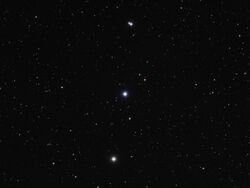Astronomy:55 Persei
| Observation data Equinox J2000.0]] (ICRS) | |
|---|---|
| Constellation | Perseus |
| Right ascension | 04h 24m 29.1556s[1] |
| Declination | +34° 07′ 50.728″[1] |
| Apparent magnitude (V) | 5.73[2] |
| Characteristics | |
| Spectral type | B8 V[2] |
| B−V color index | −0.054±0.004[2] |
| Astrometry | |
| Radial velocity (Rv) | +8.5±3.5[3] km/s |
| Proper motion (μ) | RA: +21.092 [1] mas/yr Dec.: −34.137 [1] mas/yr |
| Parallax (π) | 8.50 ± 0.38[4] mas |
| Distance | 380 ± 20 ly (118 ± 5 pc) |
| Absolute magnitude (MV) | −0.39[5] |
| Details | |
| Mass | 3.44±0.07[6] M☉ |
| Radius | 3.0[7] R☉ |
| Luminosity | 193+24 −21[6] L☉ |
| Temperature | 12,246±85[6] K |
| Rotational velocity (v sin i) | 288[6] km/s |
| Age | 197[5] Myr |
| Other designations | |
| Database references | |
| SIMBAD | data |
55 Persei is a single,[9] blue-white hued star in the northern constellation Perseus. It is faintly visible to the naked eye under good seeing conditions, having an apparent visual magnitude of 5.73.[2] Based upon an annual parallax shift of 8.50±0.38 mas[4] as seen from Earth's orbit, the star is located about 380 light years from the Sun. At that distance, the visual magnitude is diminished by an extinction of 0.39[5] due to interstellar dust.
This is a B-type main-sequence star with a stellar classification of B8 V;[2] a massive star that is generating energy through hydrogen fusion at its core. It has 3.44[6] times the mass of the Sun and about 3[7] times the Sun's radius. The star is about 197[5] million years old and is spinning rapidly with a projected rotational velocity of 288 km/s.[6] It is radiating roughly 193[6] times the Sun's luminosity from its photosphere at an effective temperature of 12,246 K.[6]
References
- ↑ 1.0 1.1 1.2 1.3 Brown, A. G. A et al. (2016), "Gaia Data Release 1. Summary of the astrometric, photometric, and survey properties", Astronomy and Astrophysics 595: A2, doi:10.1051/0004-6361/201629512, Bibcode: 2016A&A...595A...2G.
- ↑ 2.0 2.1 2.2 2.3 2.4 Anderson, E.; Francis, Ch. (2012), "XHIP: An extended hipparcos compilation", Astronomy Letters 38 (5): 331, doi:10.1134/S1063773712050015, Bibcode: 2012AstL...38..331A.
- ↑ de Bruijne, J. H. J.; Eilers, A.-C. (October 2012), "Radial velocities for the HIPPARCOS-Gaia Hundred-Thousand-Proper-Motion project", Astronomy & Astrophysics 546: 14, doi:10.1051/0004-6361/201219219, A61, Bibcode: 2012A&A...546A..61D.
- ↑ 4.0 4.1 van Leeuwen, F. (2007), "Validation of the new Hipparcos reduction", Astronomy and Astrophysics 474 (2): 653–664, doi:10.1051/0004-6361:20078357, Bibcode: 2007A&A...474..653V.
- ↑ 5.0 5.1 5.2 5.3 Gontcharov, G. A. (November 2012), "Spatial distribution and kinematics of OB stars", Astronomy Letters 38 (11): 694–706, doi:10.1134/S1063773712110035, Bibcode: 2012AstL...38..694G.
- ↑ 6.0 6.1 6.2 6.3 6.4 6.5 6.6 6.7 Zorec, J.; Royer, F. (2012), "Rotational velocities of A-type stars. IV. Evolution of rotational velocities", Astronomy & Astrophysics 537: A120, doi:10.1051/0004-6361/201117691, Bibcode: 2012A&A...537A.120Z.
- ↑ 7.0 7.1 Pasinetti Fracassini, L. E. et al. (February 2001), "Catalogue of Apparent Diameters and Absolute Radii of Stars (CADARS)", Astronomy and Astrophysics 367 (2): 521–524, doi:10.1051/0004-6361:20000451, Bibcode: 2001A&A...367..521P.
- ↑ "55 Per". SIMBAD. Centre de données astronomiques de Strasbourg. http://simbad.u-strasbg.fr/simbad/sim-basic?Ident=55+Per.
- ↑ Eggleton, P. P.; Tokovinin, A. A. (September 2008), "A catalogue of multiplicity among bright stellar systems", Monthly Notices of the Royal Astronomical Society 389 (2): 869–879, doi:10.1111/j.1365-2966.2008.13596.x, Bibcode: 2008MNRAS.389..869E.
 |

